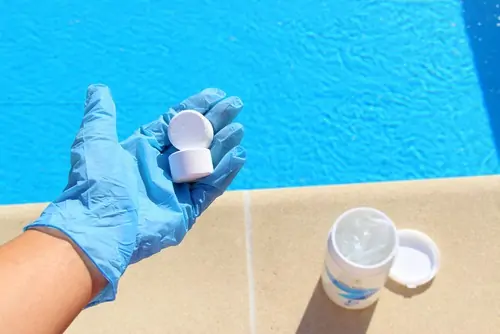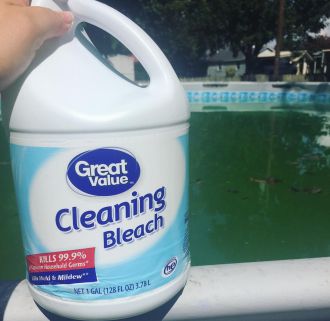Taking the plunge into the pool-ownership world is thrilling, but it comes with its own set of responsibilities. Among these, keeping your pool clean tops the list. Understanding how much liquid chlorine to add to your pool isn’t just about maintaining aesthetic appeal; it’s about health and safety.
Chlorine: The Pool’s Best Friend
Chlorine has been a staple for pool sanitation for decades. It’s a strong oxidant, which means it’s excellent at killing bacteria, algae, and other nasties that you don’t want in your pool. But chlorine is more than just a bacteria slayer; it also helps in breaking down other unwanted substances like dirt and sweat.
Why is Pool Chlorine Important?
Ignoring your pool’s chlorine levels can lead to a myriad of problems. Cloudy water, algae blooms, and even bacterial infections can arise from poor chlorine management. Plus, if you’ve invested a pretty penny in your pool setup, you don’t want the equipment to be compromised due to imbalance in water chemistry.
Types of Chlorine
Not all chlorine products are created equal. In general, chlorine comes in liquid, tablet, and granular forms. Liquid chlorine is generally easier to apply and can act faster than other forms, which is why this article focuses on that type.
How Much Liquid Chlorine to Add to Pool
Here we are, the heart of the matter. You might think that adding liquid chlorine to your pool is a no-brainer—just dump it in, right? Wrong. Adding too much or too little chlorine can have adverse effects, including damage to your pool equipment and even health risks to swimmers.
Factors That Affect Chlorine Levels
There are various factors that can affect how quickly chlorine is consumed in your pool. The number of swimmers, exposure to sunlight, and even the local weather can all impact how much chlorine you need to add.
Ideal Chlorine Levels for Different Pools
Different pools require different levels of chlorine for optimum sanitation. For instance, a pool that is frequently used by kids might need higher levels of chlorine compared to a rarely used adult pool.
Step-By-Step Guide to How Much Liquid Chlorine to Add to Pool
Before you go ahead and add chlorine to your pool, there are some preparatory steps to follow. Here’s a breakdown to guide you through this.
Preparing the Pool
Make sure that the pool water is properly circulated and that the filters are clean. Poor circulation can affect the chlorine’s effectiveness.
Safety First: Personal Protective Equipment
Don’t forget to wear gloves and eye protection when handling liquid chlorine. It’s a powerful oxidant and can be hazardous when it comes in contact with skin or eyes.
Method of Adding Chlorine
You can either pour the chlorine directly into the pool or use a chemical feeder. Make sure to follow manufacturer guidelines for best results.
When to Add Liquid Chlorine
Timing matters when it comes to adding chlorine to your pool. This section explains the best times to do it, considering factors such as sun exposure and pool usage.
Peak Sun Hours
Did you know that chlorine evaporates faster during peak sun hours? Hence, adding chlorine during this time might not be the most effective strategy.
After Pool Parties
If your pool has seen heavy use, say after a weekend pool party, it’s time to shock it with a good amount of liquid chlorine.
Routine Chlorination
Routine maintenance is key to a clean pool. Establishing a regular schedule for adding chlorine will make pool management easier.
Calculating the Right Amount
There are pool calculators available that can help you figure out just how much liquid chlorine your pool needs. It’s a good idea to double-check these figures through regular water testing.
Using a Pool Calculator
Online tools can help you estimate the amount of chlorine needed. Input your pool’s volume, and the calculator will give you an estimate.
The Importance of Regular Testing
Consistent testing is crucial for maintaining ideal chlorine levels. Invest in a good test kit and use it regularly to check your pool’s chlorine content.
Common Mistakes While Adding Chlorine
Avoid rookie errors like over-chlorinating or under-chlorinating your pool. Both can lead to issues like skin irritations or algae blooms.
Over-chlorinating
Putting too much chlorine can be as harmful as putting too little. Over-chlorination can lead to faded swimwear, dry skin, and even respiratory problems.

Under-chlorinating
Insufficient chlorine can lead to cloudy water and bacterial growth, making your pool a breeding ground for germs.
Chlorine Alternatives
While chlorine is the most popular option, it’s not the only one. Here, we delve into alternatives like saltwater systems and UV sterilization.
Saltwater Pools
Saltwater pools generate their own chlorine, offering a more natural feel without the strong smell of chlorine.
UV Sterilization
Ultraviolet light can also be used to kill bacteria and algae, but it does not replace the need for chlorine.
Pro Tips for Pool Maintenance
When it comes to keeping your pool in top-notch condition, some insider tips can go a long way. Here are a few.
Seasonal Adjustments
Chlorine levels may need to be adjusted seasonally. Higher temperatures in the summer may require more frequent chlorination.
Pool Covers
A pool cover can help maintain chlorine levels by reducing evaporation and blocking contaminants.
FAQs of How Much Liquid Chlorine to Add to Pool
How often should I test my pool’s chlorine levels?
You should test your pool’s chlorine levels at least twice a week during peak usage and weekly during the off-season.
Is it safe to swim immediately after adding liquid chlorine?
It’s generally advisable to wait at least 30 minutes to an hour after adding liquid chlorine before swimming.
Can I use other forms of chlorine along with liquid chlorine?
Yes, you can use other forms like tablets for long-term maintenance while using liquid chlorine for quick adjustments.
What should I do if I accidentally add too much chlorine?
If you over-chlorinate, you can dilute the pool water by adding fresh water or use a chlorine neutralizer.
How do I know if I need to add more chlorine to my pool?
Signs like cloudy water, strong chlorine smell, or a positive bacteria test indicate that you may need to add more chlorine.
What are the side effects of under-chlorinating my pool?
Under-chlorinating can lead to algae growth, bacterial infections, and cloudy water.
Conclusion: The Ultimate Guide for Pool Chlorination
Keeping a pool clean and safe requires some effort, but with the right knowledge, it doesn’t have to be overwhelming. Learning how to accurately determine how much liquid chlorine to add to your pool is crucial for maintaining a healthy swimming environment. In this comprehensive guide, we’ve walked you through the types of chlorine, when and how to add it, common mistakes to avoid, and even alternatives to consider. Remember, it’s better to be safe than sorry. Take your time, do your research, and if in doubt, always seek professional advice. Happy swimming!



